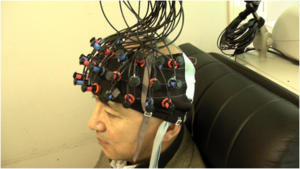Alumni Association
Dr David Turk (University of Aberdeen)
14 November 2011
![]()
Joint Research Project
Project title: A study of working memory model for random generation and its brain basis
Japanese Lead Scientist: Professor Fumihiko Itagaki, Faculty of International Relations, Asia University
UK Counterpart: Dr David Turk, School of Psychology, University of Aberdeen
Project Duration: 2007 to 2009
A study of working memory model for random generation and its brain basis
In cognitive psychology, the random number generation (RNG) task can be used to explore the attentional capacity of working memory (WM). Specifically, the RNG task allows us to explore executive processes in WM (Baddeley, 1986). This joint project was designed to explore the neural basis of human random generation by comparing verbal and key-press responses using near-infrared spectroscopy (NIRS). We developed a new key-press protocol in which participants had to generate random sequences that would not be predicted by a computer (Mouse condition) or predict the next number in the sequence selected by the computer (Cat condition). From the results obtained we were able to construct many measurement axes that reflect the different frontal activations for the Cat and Mouse tasks. In addition we also invented a novel correlation analysis method to examine behavioural and NIRS data.
Departments and institutions involved
UK: Aberdeen University
Japan:Asia University, Department of International Relations (Section of Education and Psychology)
Tokyo University, Graduate school of medicine and faculty of medicine
Fukushima medical University, Department of neuropsychiatry
How collaboration started
We met at Bristol University in 1999 to 2001 when Turk was a PhD student and Itagaki was a visiting researcher from Japan. Although the research interest of Itagaki was limited to the random number generation task and its modeling to the working memory, Turk was one the few people who understand his model. After Turk moved to Dartmouth College and Itagaki moved back to Japan, we visited each other and discussed about the need for a neuroimaging study to test the efficacy of the RNG analysis model. When Turk came to Japan in 2006, Itagaki introduced him Professor Niwa and other Japanese researchers interested in his research on self and memory and we further discussed an imaging experiment using NIRS.
Amount of money awarded
5,000,000 yen (about 40,000 pounds) for 2 years
How participants benefitted from the scheme
Funding was awarded for the Japanese team by JSPS, but the application to the Royal Society for partner funding was not supported. As a result, funding was only provided to allow researchers in Japan to travel to Europe (Aberdeen and Bristol in the UK and Berlin, Germany) to present data at conferences and to hold further discussions with Turk, with the remainder used to fund NIRS experiments conducted in Japan.
What have been the collaborative developments since the project ended
Based on research carried out in this collaborative project we have shown that processes mediated by regions of the frontal and parietal lobe are important for the control of central executive processes engaged in random number generation. assessed with the new measurements of RNG task. This model can now be applied to further understanding individual differences in executive processes using NIRS.
Has there been further applications to JSPS for funding
In 2010, with a recommendation from Turk, a postgraduate student from the University of British Columbia, Canada applied to the JSPS Summer Seminar Program to work with Itagaki on a random key-press project. She learned the basic analysis method and the data produced from that visit will be used to update the axis model developed by Itagaki. This model is currently in preparation for publication.
Further applications will be submitted in the coming months when we are able to gain access to a full head NIRS system.

Professor Itagaki demonstrating the NIRS equipment.
PDF version (84KB)
















